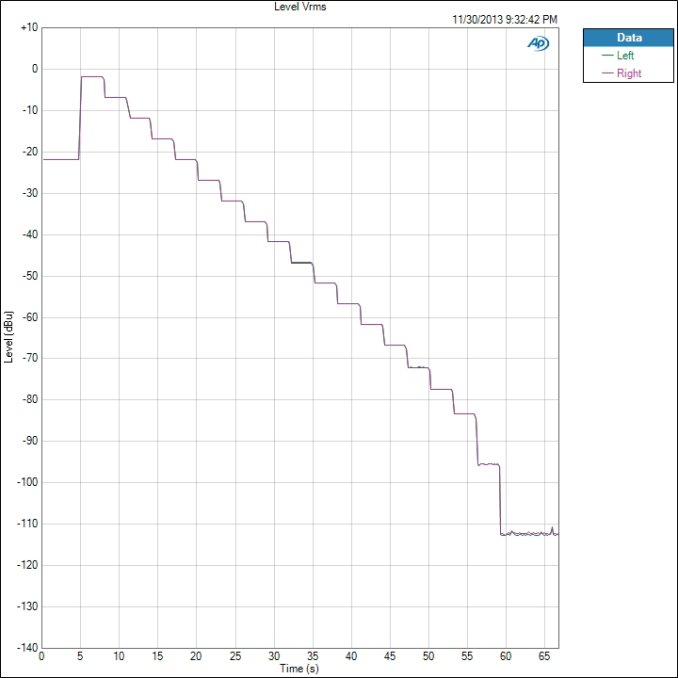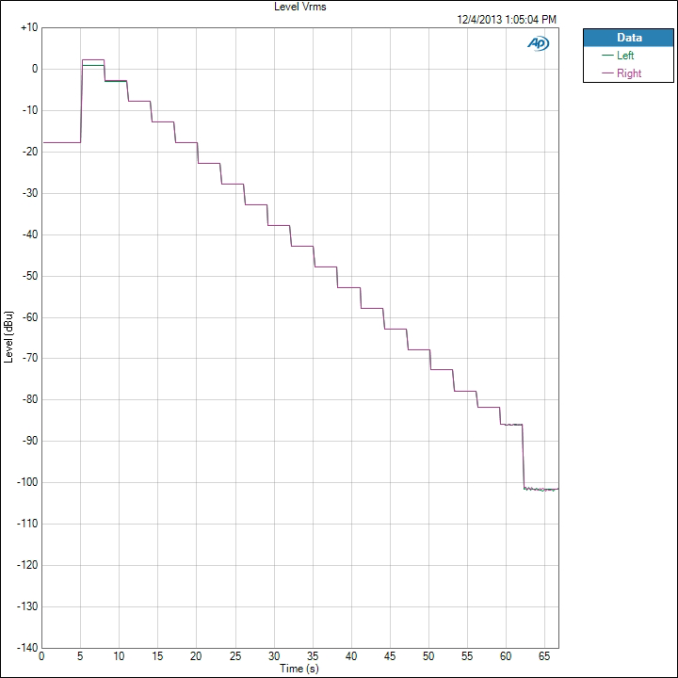Smartphone Audio Quality Testing
by Chris Heinonen on December 8, 2013 5:15 PM EST- Posted in
- Smartphones
- Audio
- Mobile
- Tablets
- Testing
Dynamic Range
The dynamic range of the phone indicates the difference between the loudest possible sound and the background noise. The more residual noise in the background, the lower the dynamic range. Phones with more powerful amplifier sections will typically produce a greater dynamic range. The residual noise level is often constant, so as the overall volume level increases the difference between the music and the noise increases as well.
The best performer here is the iPhone 5 again, with 92.214 dB of range. The worst is the Nexus 5 with only 89.332 dB. A difference of 3 dB is not something I would concern myself over. If we see a phone or tablet that drops down below 80 dB then I will start to show more concern.
Crosstalk
Crosstalk, like dynamic range, is just a number here. This is the measurement how much signal leaks from one channel into another. If an instrument should only be in the right ear, some of that signal will leak into the left ear, but we want that as low as possible. The results are expressed in -dB, or how much quieter one ear is than the intended ear.
On the Note 3 we see a wonderful crosstalk measurement of -117.2 dB so the sounds in one ear are -117 dB quieter in the other ear. This makes them impossible to hear. The worst is the iPhone 5, with only -75.624 dB of isolation.
Stepped Response
The stepped response uses a 1 kHz 0 dBFS tone but measures output level from maximum volume to minimum volume. We can see how large the volume steps are and how many there are. It doesn’t produce a number we can use, but it ties back into our other results. For a good example, we can look at the Note 3.
We see steps that are around -5 dBu each. The final level is muted and just the background noise of the device. Each step is clean and even but as we get lower and lower we see noise start to intrude. This is the background noise starting to become audible in the signal. The flatter the levels are, the quieter it will be. Now, let us look at the Nexus 5.
Notice at the very top how the right and left channels do not overlap. That is the clipping we talked about at the very beginning. It isn’t until the 4th volume setting that the level difference is down to nothing. Because of this, I would consider the top 3 volume settings of the Nexus 5 as ones that should be avoided. They each have enough THD+N introduced into them that it will sound poor, and one ear will be louder than the other.












188 Comments
View All Comments
Friendly0Fire - Sunday, December 8, 2013 - link
The Nexus S has some of the best DAC in the industry, actually... Most phones these days use the built-in Snapdragon DAC, but the S has a Wolfson DAC which is way superior.I think you either had a dud or you have another issue somewhere because the S was lauded for sound quality (just like the original Galaxy S).
tedders - Sunday, December 8, 2013 - link
I must have had a dud Galaxy S then too because my Captivate had abysmal audio.Samus - Monday, December 9, 2013 - link
The captivate and epic 4G (sprint variant) were substantially different from the galaxy s, although I remember the epic 4G touch (S2) having decent audio quality.tipoo - Sunday, December 8, 2013 - link
So I've heard, but I'm not the only one with shit audio on it, the running theory is they put in a good DAC but didn't bother properly making drivers or something for it.tipoo - Sunday, December 8, 2013 - link
Or perhaps improper shielding of the audio circuit from the radios, since the static seemed to be radio related. Even modern phones have some of that, even the best sounding ones like the iPhone 5S, but it's much much reduced.cheinonen - Sunday, December 8, 2013 - link
The DAC really means nothing without knowing everything else that goes into the circuit. Yes, the DAC might have superior SNR and THD+N but if you use an amplifier, or a volume control circuit, that are worse than other phones, you've now mitigated that advantage. It's there in the DAC but by the time it gets to the output stage it's been buried by noise elsewhere in the system.Using a better DAC is nice. But you can't just drop it in and get better results, everything else needs to be engineered around it as well.
Friendly0Fire - Sunday, December 8, 2013 - link
Using a higher end separate DAC hints that the manufacturer at least somewhat cares about sound quality. Using the built-in SoC DAC says that it's an afterthought.It's not a guarantee, but it's certainly an indicator.
Galidou - Sunday, December 8, 2013 - link
Totally agree with cheinonen, any high end audio stereo setup is as strong as it's weakest link. Take the excellent nuforce DAC-100 at ~1200$CAD, use it with a poor sub 400$ multi channel receiver and you won't get much out of it. The nuforce got plenty of amazing review, but it always depends on what it is paired with.The galaxy sure got a nice DAC but it's amplifier section is poorly engineered.
cjl - Monday, December 9, 2013 - link
Actually (and I know audiophiles everywhere will disagree with me on this, but whatever...), you can get audibly perfect sound with a dac worth only a couple hundred dollars at most, and an amp of similar cost. There's really no point in buying a >$1k dac, and the same goes for an amplifier (though expensive multi channel receivers can be justified, not for the quality of their amplifiers, but for the quality of their DSP, room correction, video upscaling, and variety of inputs and outputs). For an audio system, by far the most important component is the speakers. You should spend the vast majority of your audio budget on the transducers (speakers/headphones), then buy an amp with sufficient power to drive them to whatever level you need without distortion/clipping (which is almost always less power than recommended by audiophiles). The rest of the system can really be quite inexpensive - the built in DAC in most modern audio products is audibly flawless, and it's impossible to improve on 14AWG zip cord for the cables (from an audibility standpoint) unless you're running your wires over an extremely long distance.Now, that isn't to say that modern smartphones have reached that audibly flawless point yet - many of them haven't (especially when they have such blatant flaws as the single channel clipping shown in the review above), but many of them are a lot closer than people realize, and it really doesn't cost much to make a product audibly flawless. I remember seeing testing done on the latest iPod, and it was good enough to not contain any audible flaws. I would assume that the iPhone is similar, and the GS4 looks to also be audibly perfect in the review above (so long as 500mV p-p is sufficient to drive your headphones - this may not be the case for some less sensitive models).
speculatrix - Tuesday, December 10, 2013 - link
+1A lot of audiophile ideas simply don't stand up to basic engineering principles, and blind A:B tests show it.